Field projects
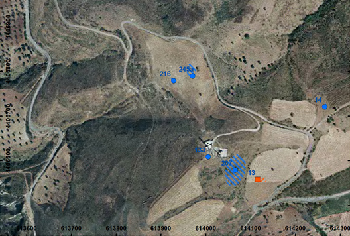
Excavations
FBA-EIA Transition Study
2018-2021
In the summer of 2018, a pilot excavation on a site called Monte San Nicola (Civita municipality, northern Calabria) was undertaken by Dr Martijn van Leusen and Dr Francesca Ippolito. This is now being followed up by a 3-year project to study settlement sites that lie on the Bronze Age – Iron Age transition, a period for which the regional pottery typochronology is not yet well understood.
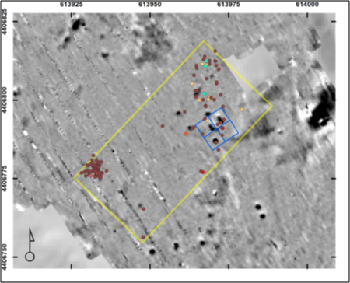
The project derives from the long-term GIA research program carried out since the year 2000 in the Raganello valley, in the north-eastern part of the region of Calabria (Attema et al. 2010; Attema & Ippolito 2017). Systematic intensive field-walking surveys carried out in this area between 2000 and 2010 resulted in the discovery of a large number of mostly small protohistoric handmade pottery scatters (figure 1). To come to a better understanding of these scatters, the Rural Life Project (2010-2015; De Neef 2016) applied high-resolution surface and subsurface investigations on representative cases, among which is the site of Monte San Nicola. Discovered already in 1987 during a hilltop survey by an Italian team (Peroni & Trucco 1991, site 8), the site was further explored by the RAP in 2002-2008 (sites 13, 14, and 207). In 2010 fresh protohistoric pottery was found on the north lobe (site 216), and this was followed up in 2011-2013 by the RLP, using pedestrian, geophysical, and coring surveys.
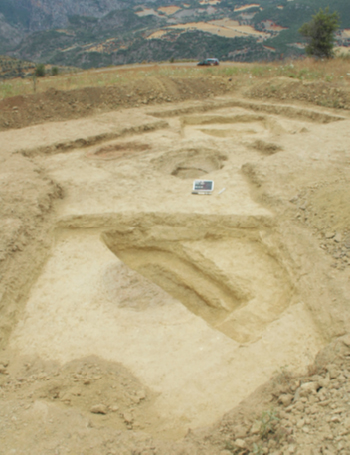
The 10 x 10m trench excavated in June 2018 (van Leusen, Ippolito 2018a; 2018b) targeted the four circular magnetic anomalies, named 245a-d (figure 3). Two (245a and d) were selected for in-depth geophysical study (see below). The plough layer was manually removed until reaching undisturbed soil, a light yellow clayey silt of fluvio-deltaic origin, at a depth of about 35 cm. Traces of plowing are already visible at 10-15 cm depth and show how sediments and archaeological materials have been transported into the plough layer, contributing to the dispersion of materials that we see on the surface. On further excavation, anomalies 245a and d proved to be dumping pits, filled at approximately the same time with a mixture of soil and debris from a nearby settlement. Anomaly 245c differs from the previous two due to the presence of a lining of red fired clay and its more elliptical shape, and we identify it as a probable oven intended for food preparation, as also attested at Torre Mordillo elsewhere in the Sibaritide (Colburn 1977; Ippolito 2019). The fourth anomaly, 245b, proved to be a pit filled with relatively clean soil and its purpose could not be established.
The analysis of the pottery fragments from the fills of the three pits and the oven reveals impasto and figulina bowls and jars with parallel rib decoration, collar necks, in-turning rims, horizontal handles, and incised and painted decorations precisely datable to the Bronze – Iron Age transition (FBA3-EIA1a). The assemblage, made up of large vessels (pithoi), proto-geometric pottery, and hand-made coarse jars and fine cups/bowls), is similar to FBA-EIA assemblages found further south in the area of Crotone, like at Monte Pedalacci and Serre d’Altilia.
Large amounts of bone fragments were collected, mainly from pit 245d. Most of the seventeen fragments that could be put to species and skeletal element are teeth and metapodial fragments, which are relatively resistant to trampling. Three common domesticated species have been identified: Bos taurus (cattle), Sus scrofa (pig) and Ovis aries / Capra hircus (sheep/goat). Due to the wear and lime encrustation on the bones, no butchery marks or pathologies could be identified.
During the excavation, detailed 3D geophysical prospections were carried out in and over anomalies 245a and 245d with the aim of understanding the relation between these anomalies and the underlying buried features. 25 cm resolution magnetic gradiometer surveys, using a Geoscan FM256 instrument, were repeatedly conducted and all natural and anthropogenic layers and deposits were sampled for later Magnetic Susceptibility analysis. With the help of external experts, these data will be used for a methodological study of the geophysical ‘signature’ of different types of pit-like features. Directional block samples were taken from the oven 245c in order to measure both the firing temperature and the magnetic remanence, needed to model the geophysical difference between this oven and the two rubbish pits.
Bibliography
Attema P.A.J., Delvigne J., Drost E., Kleibrink M. 2000 , Habitation on Plateau I of the hill Timpone della Motta (Francavilla Marittima, Italy): a preliminary report based on surveys, test pits and test trenches in Palaeohistoria 39/40 (1977/1998), Rotterdam, pp. 375-411.
CRUDO, M. 2018a, Ricezione, interazione e trasformazioni in due centri indigeni della Calabria Ionica nell’Età del Ferro: Francavilla Marittima e Canale Janchina, in M. d’ANDREA, M. CORRADO (a cura di), Achille Solano. Ricercatore gentiluomo. Atti della giornata di studio Nicotera, 25 aprile 2015, pp. 41-78.
CRUDO, M. 2018b. Greek migrations along the Ionian Coast (Southern Italy), in Ex Novo Journal of Archaeology 3 (December 2018), pp. 21-42.
De Neef, W., Armstrong, K. & M. van Leusen, 2017. Putting the spotlight on small protohistoric pottery scatters in northern Calabria (Italy). Journal of Field Archaeology 42(4): 283-297. http://dx.doi.org/10.1080/00934690.2017.1332930.
De Neef, W., M. van Leusen, K. Armstrong & B. Ullrich, 2018. Between a rock, a gully, and a hard place. Archaeological prospection of Metal Age remains in the uplands of the Raganello basin (Calabria, Italy). In Wohlfarth, C. & C. Keller (eds), Funde in der Landschaft / Finds in the Landscape (Materialien zur Bodendenkmalpflege 26): 159-170. Landschafts Verband Rheinland.
IPPOLITO F. 2019, Struttura da fuoco da Monte san Nicola a Civita (CS), in Peinetti A., Cattani M., Debandi F., eds. Sesto Incontro Annuale di Preistoria e Protostoria: Focolari, forni e fornaci tra Neolitico ed età del Ferro, Istituto Italiano di Preistoria e Protostoria, Firenze, 80-82.
IPPOLITO F., VAN LEUSEN M. 2019, Archeologia a Civita e il Progetto Archeologico Raganello, Magazine Katundi Ynë - Paese Nostro, Rivista italo-albanese di cultura e attualità, anno 50, n.1/2019, 8-10.
IPPOLITO F., M. VAN LEUSEN 2018, Progetto Pilota Monte San Nicola - Civita (CS), Campagna di scavo 2018, poster, 58o Convegno Internazionale di Studi sulla Magna Grecia, 27-30 Settembre, Taranto.
IPPOLITO F., P.A.J. ATTEMA 2018, Connettività regionale e interregionale in età Preistorica e Protostorica nella valle del Raganello (Regional and interregional connectivity in Pre- and Proto-historic times in the Raganello valley), in Colelli C., Larocca A. (eds.), “Il Pollino barriera naturale e crocevia di culture”, Giornate internazionali di archeologia, 16-17 April 2016, San Lorenzo Bellizzi (CS), 29-37.
IPPOLITO F. 2017, La Galleria dei vasi della Grotta di S. Angelo II. Nuovi dati sul Protoappenninico della Sibaritide e sulle sue relazioni con le sponde adriatiche, XLVII Riunione Scientifica Preistoria e Protostoria della Puglia (Ostuni 2012), Firenze, pp. 1019-1024.
Van Leusen, P.M. & W. de Neef, 2018. On the trail of pre- and protohistoric activities around San Lorenzo Bellizzi. Geo-archaeological studies of the University of Groningen, 2010-2015. In: Colelli, C. & A. Larocca (eds), Il Pollino, barriera naturale e crocevia di culture. Ricerche, collana del Dipertimento di Studi Umanistici Sezione Archeologia, XII. Università di Calabria, pp. 39-48.
Van Leusen, P.M. & N. Oome, 2018. Q130: surveys op het terrein van een Hellenistische en Romeinse boerderij in zuid-Italië. PaleoAktueel 29: 27-34.
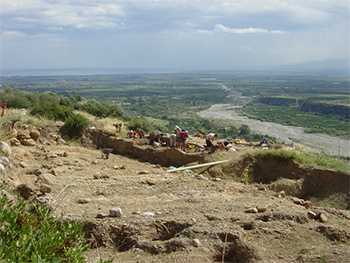
Timpone della Motta
Between the years 1993-2004 and between 2008 and 2010 the GIA conducted excavations in the sanctuary on the Timpone della Motta. These brought to light the remains of three superimposed sacred buildings (Vb-Vd) dating to the period from c. 800 to the middle of the 7th century BC.
The three excavated buildings provided valuable insights in the religious transformation of the sanctuary from an indigenous cult place in the 8th and early 7th century BC into a Greek inspired one in the 7th century BC. In the 6th century BC the sanctuary achieved the height of its monumentalisation.
Archaeological research at the Timpone della Motta site has targeted the issue of the cultural assimilation of indigenous and exogenous groups before and after the foundation of ancient Sibari.
Between 1963 and 1969, the Italian archaeologist Paola Zancani Montuoro started to excavate at the Iron Age Macchiabate Necropolis, situated at the foot of the Timpone della Motta hill. In 2009 the University of Basel, under the direction of Prof. M.A. Guggisberg and initially in collaboration with the Groningen Institute of Archaeology, started a new excavation project at the Macchiabate Necropolis. Its oldest tumuli burials were found to belong to an extended family, one branch of which is thought to have climbed to aristocratic rank in the mid-8th century BC because of its increasingly conspicuous display of wealth and status. The excavations of the University of Basel are now carried out independently.
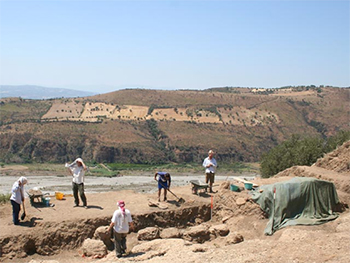
Area Rovitti
The area Rovitti is located on the lower southern slope of the Timpone della Motta. A survey conducted in the area in 2007 had already revealed remains of pottery kilns and associated locally manufactured pottery from the 8th century BC. This indicated that a Kerameikos was active in the area during the Early Iron Age.
Excavation campaigns were carried out in 2009-2010, which brought to light two well-preserved dwelling (Structure A and Structure B) from the Early Iron Age containing high quantities of Oenotrian-Euboean pottery. The excavations carried out in the Rovitti area showed that the indigenous society experienced foreign influence, visible in the material culture, already from the end of the 9th century BC onwards. Within this framework, the identification of locally manufactured pottery of a clear Euboean matrix has raised notable attention and scholarly debate. This “Oenotrian-Euboean” pottery was until recently mainly attested in small amounts in the sanctuary on the Timpone della Motta, and was largely missing from the graves and habitation areas of the Early Iron Age.
Bibliography
Attema P.A.J., Delvigne J., Drost E., Kleibrink M. 2000 , Habitation on Plateau I of the hill Timpone della Motta (Francavilla Marittima, Italy): a preliminary report based on surveys, test pits and test trenches in Palaeohistoria 39/40 (1977/1998), Rotterdam, pp. 375-411.
Attema P.A.J., Burgers G. J., van Leusen P. M. 2010 , Regional Pathways to complexity. Settlement and land-use dynamics in early Italy from the bronze age to the republican period, Amsterdam.
Colelli C., Jacobsen Kindberg J. 2013 , Excavation on the Timpone della Motta. Francavilla Marittima (1991-2004). II. Iron Age Impasto Pottery, Bari.
Fasanella Masci M. forthcoming, La produzione della ceramica geometrica enotria nella Sibaritide. Studio comparativo sulle tecnologie di foggiatura. Phd Thesis, University of Groningen, Groningen.
Guggisberg M.A., Colombi C., Spichtig N. 2013 , Gli scavi dell’Università di Basilea nella necropoli Enotria di Francavilla Marittima, Bollettino d’Arte, 15, luglio-settembre 2012, Serie VII), Tivoli (RM), pp. 1-18.
Ippolito forthcoming , Before the Iron Age: the oldest settlement in the Sibaritide, Calabria (Italy), PhD Thesis, University of Groningen.
Jacobsen J.K. 2007 , Greek pottery on the Timpone della Motta and in the Sibaritide from c. 780 to 620 B.C. Reception, distribution and evaluation of Greek pottery as a source material for the study of Greek influence before and after the founding of ancient Sybaris, PhD Thesis, University of Groningen, Groningen.
Jacobsen J.K., Handberg S. 2010 , Excavation on the Timpone della Motta. Francavilla Marittima (1992-1994). I. Greek pottery, Biblioteca Archeologica, Bari.
Kleibrink M. 2001 , The search for Sybaris: an evaluation of historical and archaeological evidence, BABesch 68, 76.
Kleibrink M. 2006 , Oenotrians at Lagaria near Sybaris, a native proto-urban centralised settlement. A preliminary report on the excavation of the timber dwellings on the Timpone della Motta near Francavilla Marittima, Southern Italy, London.
Kleibrink M., Jacobsen J.K., Handberg S. 2004 , Water for Athena: votive gifts at Lagaria (Timpone della Motta, Francavilla Marittima, Calabria), in R. Osborne (ed.), The objects of dedication, in WorldA, 36, London, pp. 43-68.
Pacciarelli M. 2010 , Verso i centri protourbani. Situazioni a confronto da Etruria meridionale, Campania e Calabria, Scienze dell’Antichità, 15 (2009), Roma, pp. 371-416.
Peroni R., Trucco F. (eds.) 1994 , I-II, Enotri e Micenei nella Sibaritide, Broglio di Trebisacce, Taranto.
Vanzetti A., Ferranti F. Quondam F. 2014 , L’età del ferro del Cosentino nelle collezioni del Museo, in Cerzoso M., Vanzetti A. (eds.), Museo dei Bretti e degli Enotri, Catalogo dell’esposizione, Soveria Mannelli, pp. 45-48.
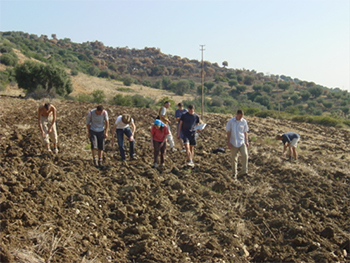
Surveys
Between 1991 and 2000 the Groningen Institute of Archaeology carried out topographic surveys in the area between Timpone della Motta and Broglio di Trebisacce and revisited archaeological sites in the hinterland that had been recorded since the 1980s by the local Sparviere Speleological Group. The collaboration between speleologists and GIA archaeologists made it possible to bring together the documentation of various site visits done by both parties in the past. From 2000 onwards a systematic approach to the landscape was introduced with the start of the Raganello Archaeological Project. So far intensive surveys have been undertaken in the foothills of Francavilla, from Timpone della Motta-Macchiabate up to the Contrada Damale which is bounded by the river Caldana at Cerchiara. Surveys have also been conducted in the territories of Civita and San Lorenzo Bellizzi. In 2005 P.M. van Leusen started the Hidden Landscape Project, in which he studied the effects of the anthropogenic and natural processes on the archaeological landscape in the Raganello valley.
By 2010, about 13 square kms, or 4% of the study area had been surveyed. Intensive survey proved possible only in accessible areas, with a high percentage of worked (ploughed) and unenclosed/open land, like in the foothill zones. In the upland zone, land use tends to be much less intensive, because of steep outcrops of limestone rocks, vegetation coverage, and limited accessibility. As a consequence, it was not always possible to carry out intensive surveys in that area. Extensive and topographic surveys were conducted instead. Extensive surveys were done in the area of Monte Sellaro (Cerchiara), Civita, San Lorenzo and Frascineto. In 2011, van Leusen and de Neef started the Rural Life Project in Protohistoric Italy which concentrated on the detection, evaluation and classification of small protohistoric pottery scatters through a combination of intensive artefact survey, geophysical prospecting and test pitting.
Field-walking surveys by the Groningen Institute of Archaeology in the Sibaritide have shown that protohistoric sites are mostly represented on the surface by worn and often poorly preserved pottery sherds that are difficult to date. As a consequence, understanding how surface artefact scatters can define chronology and function of sites became one of the goals of research within the Raganello Archaeological Project. This implied the development of additional material study strategies that led to detailed and effective typological and archaeometric analysis on pottery. Further field investigations, such as geophysical, geoarchaeological, and remote sensing techniques, together with botanical, archaeozoological and environmental analyses have been conducted aiming for a holistic landscape archaeology.
The field surveys have resulted in a rich archaeological database on archaeological sites from prehistory to the Roman period that is currently being prepared for publication in the Raganello Basin Studies of the Groningen Institute of Archaeology .
Bibliography
Attema P.A.J. 2002 , Two challenges for Landscape Archaeology, in Attema P.A.J., Burgers G.-J., Joolen van E., Leusen van M., Mater B. (eds.), New developments in Italian Landscape Archaeology, BAR 1091, Oxford, pp. 18-27.
Attema P.A.J., Burgers G. J., van Leusen P. M. 2010 , Regional Pathways to complexity. Settlement and land-use dynamics in early Italy from the bronze age to the republican period, Amsterdam.
Attema P.A.J., Ippolito F. forthcoming, Il Progetto Archeologico Raganello (RAP) – Sviluppo insediativo di lunga durata nell’hinterland della Sibaritide protostorica, Atti del Convegno “Centri fortificati indigeni della Calabria dalla protostoria all’età ellenistica,” Collana Archeologie. Temi e metodi, Università degli Studi di Napoli Federico II, Centro Interdipartimentale di Studi per la Magna Grecia, Napoli.
De Neef W. forthcoming, Rural life in Protohistoric Italy: Relating subsurface remains to archaeological survey data, Phd Thesis, University of Groningen, Groningen.
Feiken H. 2014 , Dealing with biases. Three geo-archaeological approaches to the hidden landscapes of Italy, PhD Thesis, University of Groningen, Groningen.
Feiken H., Van Beek R., Van Asch T., Van Leusen M. 2011 , CALEROS: an erosion-deposition model for landscape archaeology, in Van Leusen M., Pizziolo G., Sarti L. (eds.), Hidden Landscapes of Mediterranean Europe, Proceedings of the international meeting, Siena, Italy, May 25-27, 2007, Oxford, pp. 13-16.
Haagsma B.J. 1996, Survey in de Sibaritide, Calabrië. Een preliminair verslag van drie campagnes, TMA 17, Eelde, pp. 47-52.
Ippolito F. forthcoming, Before the Iron Age: the oldest settlement in the Sibaritide, Calabria (Italy), PhD Thesis, University of Groningen.
Peroni R., Trucco F. (eds.) 1994 , I-II, Enotri e Micenei nella Sibaritide, Broglio di Trebisacce, Taranto.
van Leusen P.M. 2002 , Pattern to process. Methodological investigations into the formation and interpretation of spatial patterns in archaeological landscapes, PhD Thesis, University of Groningen, Groningen.
van Leusen P.M. 2012 , The Rural Life Project Autumn 2012 field campaign (RL2012-2): preliminary report, Groningen.
van Leusen P.M. 2013 , The Rural Life Project: preliminary report on the Spring 2013 field campaign (RL2013-1), Groningen Institute of Archaeology, 19 April 2013, p. 1.
van Leusen, P.M. 2015 , Predicting and detecting protohistoric remains in the Raganello Basin: methodological studies 2006-2015, in G. Pizziolo & L. Sarti (eds), Predicting Prehistory. Predictive models and field research methods for detecting prehistoric contexts. Proceedings of the International Workshop Grosseto (Italy), September 19-20, 2013 (MILLENNI Studi di archeologia preistorica 11), Museo e Istituto Fiorentino di Preistoria, Firenze pp. 123-132.
van Leusen M., Attema P.A.J. 2001-2002 , Regional archaeological patterns in the Sibaritide. Preliminary results oft he RPC field survey campaign 2000, Palaeohistoria 42/43, Groningen, pp. 1-23.
| Last modified: | 24 July 2024 3.38 p.m. |
